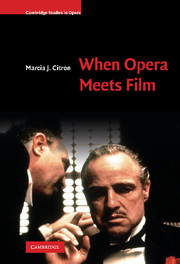Book contents
- Frontmatter
- Contents
- List of figures
- List of tables
- List of music examples
- Acknowledgments
- Introduction
- Part I Style
- 1 Operatic style in Coppola's Godfather trilogy
- 2 Opera as fragment: “Liebestod” and “Nessun dorma” in Aria
- Part II Subjectivity
- Part III Desire
- Epilogue
- Notes
- Bibliography
- Filmography and videography
- Index
1 - Operatic style in Coppola's Godfather trilogy
from Part I - Style
Published online by Cambridge University Press: 04 August 2010
- Frontmatter
- Contents
- List of figures
- List of tables
- List of music examples
- Acknowledgments
- Introduction
- Part I Style
- 1 Operatic style in Coppola's Godfather trilogy
- 2 Opera as fragment: “Liebestod” and “Nessun dorma” in Aria
- Part II Subjectivity
- Part III Desire
- Epilogue
- Notes
- Bibliography
- Filmography and videography
- Index
Summary
The Godfather trilogy of Francis Ford Coppola is an icon of American culture and international cinema. Released over a span of eighteen years, the group includes The Godfather (1972), The Godfather Part ii (1974), and The Godfather Part iii (1990). Godfather i set box-office records and became that rare film that achieved both commercial and artistic success. While not as popular with audiences, Godfather ii earned high praise from critics and like Godfather i received the Oscar for Best Picture. The final installment inspired much less enthusiasm, and many reviews thought the series had outrun its time. There was no plan at the outset for sequels, but they evolved because Paramount was eager to profit from the success of the predecessor.
The films have attracted considerable critical attention. In reviews and scholarly studies alike, operatic features are often ascribed to the films. Literary critic Paul Giles, for instance, writes that “Whereas Puzo's novel emphasizes plot and fast action, Coppola's films emphasize lavish, operatic ritual,” and he mentions “the hyperbolic and operatic elements in the films – the decapitated horses, the ritual slaughters, and so on …” For film critic Pauline Kael, “Coppola is the inheritor of the traditions of the novel, the theater, and – especially – opera and movies.” She contends that Godfather ii has “the same mythic and operatic visual scheme as the first …” Part i, she observes two years earlier, is characterized by a “dark-and-light contrast [that] is so operatic and so openly symbolic that it perfectly expresses the basic nature of the material.”
- Type
- Chapter
- Information
- When Opera Meets Film , pp. 19 - 57Publisher: Cambridge University PressPrint publication year: 2010
- 1
- Cited by



